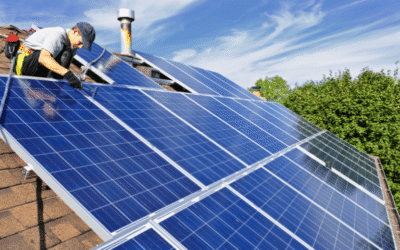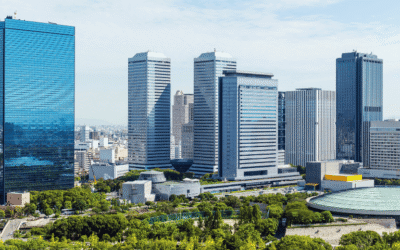Energy consumption is often extremely high when it comes to commercial spaces. However, it does not have to be. Below, the expert electricians with Action Services Group provide several energy-saving tips for commercial buildings!
Energy Saving Tips for Commercial Buildings
Commercial spaces can benefit from one or all of the following energy-saving strategies below. If you are tired of high power bills, it may be time to review several different aspects of energy consumption.
Repair or Retrofit Your Lighting
One of the biggest energy expenditures stems from your lighting system. If you have noticed flickering lights, are still using incandescent or fluorescent fixtures, or simply have not had your lighting evaluated by a professional in a few years – it may be time!
When light systems are flickering or experiencing other issues, rest assured they are wasting energy. This is because they are struggling to provide the proper power to the fixtures and, therefore, are drawing more heavily on electrical sources to compensate. (This can also be an indication of a potential safety hazard! If wires are shorting out, for example, this can lead to fires.)
Furthermore, the type of lights you have affects how much energy is needed to power them. Incandescent and halogen lamps are the least efficient types available today. In fact, when compared to all other types of lights on the market, light-emitting diode (LED) lamps can save you 25% to 90% on your power bill. (LED lights also last much longer than other types of lamps. They are also more durable, which means they will withstand vibrations, shocks, and falls that other lamps will not.)
LED lights come in a vast array of shapes, sizes, and colors. Not only can they be installed in ceiling fixtures, but they can also be used in things like emergency signs. Because of the different LEDs available today, there are plenty of options. From parking garages and industrial lots to office spaces and warehouses, there are LED lamps to fit any need.
Action Services Group specializes in LED retrofits and lighting services. With over 25 years of industry experience, we are standing by to answer any of your questions. If you would like to book a meeting to speak with one of our lighting specialists, you can click here or the button below.
Consider a Lighting Control System
While considering your lighting, you may also want to evaluate a lighting control system. There are plenty of options available here too.
Spaces that are occupied occasionally, but where lights are continuously left on, waste energy. Occupancy sensors can turn lights on and off as motion is detected. This means power is not wasted when spaces, such as bathrooms, are unoccupied.
Daylight sensors can also help to reduce power loads. These sensors detect ambient light and adjust lighting levels based on how much daylight is present. If your spaces are primarily utilized during the day, this means the lights are reduced automatically because of the daylight streaming through the windows into the office.
Timers can also help. Whether pre-programmed or scheduled via smartphone applications, these can automatically turn lights on and off during scheduled hours. For example, if your office building is open from 8:00 AM to 8:00 PM, a timer can ensure the lights are programmed to turn on and off to support occupancy during this time.
Lighting control systems can be as complex or as simple as you want. Often custom-designed to fit your needs, these systems can help maximize energy efficiency.
If this section has piqued your interest and you would like to learn more about lighting controls, we suggest starting with our blog: Introduction to Lighting Control Systems. This is the first blog in our Lighting Control Systems Series, designed to take you from initial education to implementation.
Update Server Rooms
When it comes to energy-saving tips for office buildings, you cannot overlook server rooms. Often an absolute must for offices today, these rooms tend to draw a lot of power.
Cloud services can help cut down on some of this expense. As cloud servers become more secure, plenty of businesses have begun to migrate some, or all, of their data to these digital servers instead of using physical ones within their offices.
However, you may not be quite ready for that. That’s ok too. Talk to your IT manager about potential energy-reduction means. Increasing airflow or inlet temperatures, for example, can help reduce the power used by servers and therefore, reduce your energy consumption.
Power Management Settings
Printers, computers, and other such devices are some of the most essential pieces of equipment when it comes to office buildings. However, they are often overlooked when owners are trying to evaluate the best way to cut energy costs. But even these devices wasting electricity during the day.
Almost all modern electronics come with a power management setting. (We are not talking about computer “screen saver” mode here! Even that wastes energy.) Often easy to configure, these settings make your devices as energy-efficient as possible. While these devices do not draw on your electricity as much as lighting does, adjusting the power management settings on your office equipment can absolutely help to reduce your power bill.
Audit Power Management Settings Regularly
Power surges, unintentional human errors, and other such factors can occasionally reset your electronics’ power management settings. Because of this, it is important to check them regularly. By auditing your power management settings, you can ensure they are still accurately set. It also means that, if new patches are pushed by the manufacturer that upgrade energy-savings software, you can adjust settings to the improved version.
Utilize Thermostat Settings
We have all been there. When multiple people occupy a space, someone is always too cold while someone else is always too hot. This is just a fact of life. However, adapting an energy-saving thermostat strategy can save you money, and please most of the people in a shared space.
Not only can thermostats be set to a steady temperature during specified times, but they can also be adjusted to meet with seasons changes. This can ensure your heating and cooling system is always optimized for energy efficiency. Small personal fans or an extra “office coat” can help employees stay comfortable no matter what the thermostat is set at, while you continue to save money on your power bill.
Increase Roof Insulation
During the winter, much of your heat escapes through a poorly insulated roof. Likewise, when it is hot outside, heat absorbed by a roof can be transferred inside, causing your air conditioning to work harder and waste more money. (In fact, office buildings are known to lose 20% of their heat through a poorly insulated roof during the winter.)
By increasing your roof insulation, you can better contain the heating and cooling of your interior spaces. Adding fans to circulate warm air at the top of a building can also help to decrease overall heating costs. These efforts mean that your air conditioning unit can run more efficiently since it does not have to compensate for a poorly insulated roof.
Educating Building Occupants Increases Commercial Building Energy Efficiency Too!
It may not be directly related to increasing energy efficiency but educating building occupants about energy consumption has proven effective over the years. In fact, initiatives that educate occupants often result in a 10% reduction in energy consumption.
For example, depending on location, a personal heater can skew thermostat readings. If a personal heater is located near to where the thermostat takes temperature readings, it can pre-maturely turn the system off by giving a false reading. If this occurs, management should be properly notified so that a better solution can be reached.
Furthermore, occupants and customers alike both tend to have a higher satisfaction rating when a company demonstrates environmentally friendly initiatives. Energy efficiency is one of those initiatives!
Energy Efficient Lighting with Action Services Group
Action Services Group specializes in addressing all your lighting needs. If you are interested in learning more about how your lighting can help you reduce your energy consumption, we can help. Contact Action Services Group today to learn more about energy-efficient lighting, by calling 610-558-9773, email [email protected] or schedule a call.








































0 Comments